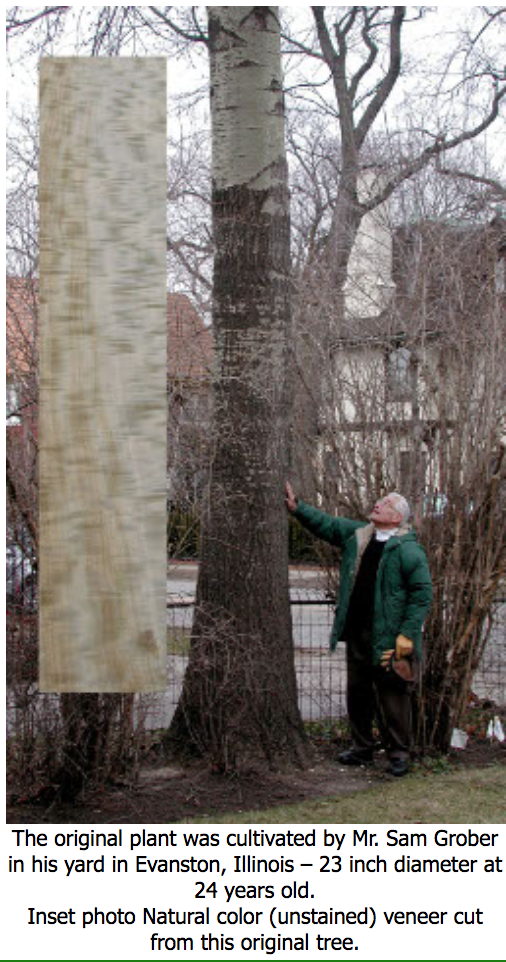|
History of Curly Poplar
Rick Meilan, Ph.D.
Professor of Molecular Tree Physiology, Department of Forestry and Natural Resources, Purdue University

Sam Grober and Figured Poplar
During World War II, Sam Grober received a deferment that allowed him to complete his Ph.D. at the University of Maryland in 1942 before being shipped off to the South Pacific by the U.S. Army. His dissertation was entitled: “The Botanical, Erosion Control, and Economic Significance of White Poplar in Maryland.” His stipend was funded by the progenitor to the modern-day Soil Conservation Service, the Soil Erosion Service, which was formed in response to the Dust Bowl of the 1930s. Sam’s goal was to find a high-value crop that could be rapidly established on a site to help prevent additional soil loss.
At the time, there was a thriving business for figured poplar (species within the genus Populus) in Maryland. Figure is a term used to describe specific, well-defined patterns in wood produced by a variety of tree species. These patterns, which occur on surfaces of lumber or veneer, result from variations in texture, grain, and color, as well as cutting method. In the case of Sam’s tree, the alternating pattern of opalescent wood is due to periodic changes in the orientation of the cells making up the wood in its bole. Constituents in the cell walls reflect and refract light, and these properties change with cell orientation, and the angle from which the wood is viewed. Trees with certain types of figure are considerably more valuable than those that produce normal, straight-grained wood.
Figured poplar seemed ideal for Sam’s Ph.D. project. It was, indeed, valuable, and trees could be vegetatively propagated relatively easily. Once established at a wide spacing, they were coppiced to induce the formation of stump sprouts and root suckers, leading to a more fully occupied stand. Poplars also produced a system of fibrous surface roots that would be effective at holding the soil.
 After the war ended, Sam served under General Douglas MacArthur in Japan during its reconstruction, traversing the country to classify its forest resources and eventually writing a portion of the Japanese constitution, granting the Emperor’s holdings to the people. Upon his return to the U.S., Sam discovered that the building housing materials he amassed while pursuing his Ph.D. had burned down in his absence. About this time, he started his long career as a buyer for the R.S. Bacon Veneer Company, and later as a manufacturer’s representative with Pierson Hollowell Company in Chicago, Baltek, and others. After the war ended, Sam served under General Douglas MacArthur in Japan during its reconstruction, traversing the country to classify its forest resources and eventually writing a portion of the Japanese constitution, granting the Emperor’s holdings to the people. Upon his return to the U.S., Sam discovered that the building housing materials he amassed while pursuing his Ph.D. had burned down in his absence. About this time, he started his long career as a buyer for the R.S. Bacon Veneer Company, and later as a manufacturer’s representative with Pierson Hollowell Company in Chicago, Baltek, and others.
In 1980, Sam took his family to the area where he conducted the field work for his Ph.D. project. While there, he discovered that a local mill had sliced veneer from a figured poplar tree that had blown down during a recent storm. Sam collected cuttings from this tree and transported them back to Evanston, IL. He was able to get one of these cuttings to root before planting it in his front yard in 1981.
Throughout his career, Sam remained certain of figured poplar’s potential as a viable commercial product. He tried to convince others of this at various conferences and trade shows. In 2004, he visited Purdue University, where he attempted to get researchers interested in studying figured poplar. He was eventually directed to the office of Rick Meilan, who had recently been hired by the Department of Forestry and Natural Resources. It soon became apparent they had many common interests, and Sam agreed to sponsor some research related to figured poplar.
In September of 2007, after nearly three years of study, they had the tree in Sam’s front yard felled. The two bottom logs were transported to Edinburg, IN, where they were sliced into veneer by the David R. Webb Company. Some of the resulting veneer was laid up into 4’ x 8’ panels by the Select Veneer Company in Smithfield, KY. From there the panels were stained and finished at Enviro Finishing of Richmond, IN. Poplar readily accepts finishes and stains, which are applied to mimic the appearance of wood from other tree species, and to accentuate the figure. These panels were then cut into 12” x 12” samples to help convince skeptics of the value of this tree, which many people heretofore have considered to be merely a weed. Some of those samples, along with a propagule of Sam’s tree, are now housed here at the Paine Garden and Art Center.
`Curly Poplar` is a distinct variety of poplar due to its highly figured wood. The highly figured wood is due to the tree's undulating cross grain which results in a strong mottle-figured grain. All the other characteristics of this poplar tree are similar to those of Populus canescans and Populus alba.
|
|
